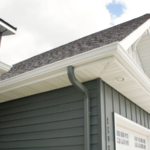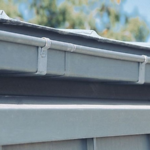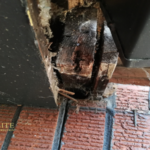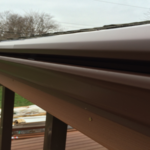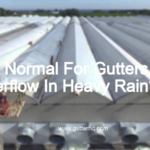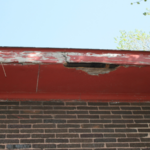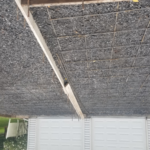2013 was a particularly rainy year in many parts of the United States. Some areas saw as much as 60 inches of rain, which is more than double the yearly average. With all that rain came a lot of overflowing gutters.
Gutters are designed to channel water away from your home, but they can only handle so much. When it rains extremely hard, the amount of water flowing down your gutters can overwhelm them. This can cause water to spill over the sides and onto your home’s foundation.
If you live in an area that gets a lot of rain, it’s a good idea to check your gutters regularly to make sure they’re not clogged. Clogged gutters can’t handle as much water, so they’re more likely to overflow.
Is it normal for gutters to overflow in heavy rain?
Overflowing gutters are not normal and can be caused by a few different things. Clogged gutters are the most common cause of overflowing gutters. When gutters are clogged with leaves and debris, they can’t drain properly and will overflow when it rains. Another common cause of overflowing gutters is improper slope. Gutters should be installed with a slight slope so that water can drain properly. If the gutters are installed level or with too much of a slope, they will overflow. Improperly installed gutters can also cause leaks, which will cause the gutters to overflow.
What causes gutters to overflow?
There are a few potential causes of gutters overflowing. One is that the gutters are simply too small for the amount of rainfall the area receives. Another possibility is that there is debris in the gutters that is blocking the flow of water. This can be leaves, twigs, or even small animals that have made their way into the gutters. Finally, the gutters may be pitched incorrectly, causing water to pool in them instead of flowing through to the downspout.
What happens if gutters overflow?
- Damage to your foundation: Overflowing gutters can cause water to pool around your foundation, which can lead to cracking and other damage.
- Damage to your landscaping: Excess water can kill plants and damage your lawn.
- Roof damage: Gutters that overflow can cause water to back up under your shingles, which can lead to leaks and other damage.
- Insect problems: Standing water in gutters is a perfect breeding ground for mosquitoes and other pests.
How do you fix overflowing rain gutters?
The most common way to fix overflowing rain gutters is to clean them out. You can do this yourself by using a ladder to reach the gutters and using a garden hose to rinse out the debris. If the gutters are particularly dirty, you may need to use a pressure washer.
If your gutters are still overflowing after cleaning them out, it may be because they are too small for the size of your roof. In this case, you will need to install larger gutters. You may also need to install additional downspouts to help move the water away from your foundation.
How much weight can rain gutters hold?
Rain gutters are designed to handle a certain amount of water weight. This amount varies depending on the size and type of gutter, but is typically around 50 pounds per square foot. Some gutters may be able to hold more or less water weight, but this is a general guideline.
While rain gutters are designed to hold a certain amount of water weight, they can become overloaded if there is too much water. This can cause the gutters to sag or even collapse. If you think your rain gutters might be overloaded, it is best to contact a professional to have them checked out.
There are a few things you can do to help reduce the amount of weight your rain gutters have to hold. First, make sure your gutters are properly cleaned and maintained. This will help ensure that they are able to handle the amount of water they are designed for. Secondly, you can install gutter guards or covers. These can help to keep leaves and other debris from clogging up your gutters and causing them to overflow.
If you are concerned about the amount of weight your rain gutters are holding, it is best to contact a professional. They will be able to assess the situation and make sure that your gutters are up to the task.
How much water can a rain gutter handle?
A rain gutter is a linear channel used to redirect rainwater away from a structure. They are installed along the roofline of a building and collect rainwater as it falls, channeling it away from the building to reduce water damage.
Rain gutters come in a variety of sizes and shapes to accommodate different building types and needs. The size of a rain gutter is determined by the amount of rainfall the area receives and the size of the building. The shape of the rain gutter also plays a role in its ability to handle water. Some common rain gutter shapes include K-style, half-round, and box.
K-style gutters are the most common type of rain gutter. They are named for their shape, which resembles the letter K. K-style gutters are available in a variety of sizes and are typically made from aluminum, vinyl, or steel.
Half-round gutters are another popular type of rain gutter. As the name implies, they are half the size of a K-style gutter and are typically made from copper or stainless steel. Box gutters are the largest type of rain gutter and are typically used on commercial buildings.
No matter the size or shape, all rain gutters have one common goal: to redirect rainwater away from the building to reduce water damage.
Is it normal to have standing water in gutters?
It’s normal for gutters to have a small amount of standing water in them, but if you’re noticing a lot of water pooling in your gutters, there could be a problem. If your gutters are full of water, they’re not able to do their job of directing water away from your home, which could lead to water damage. There are a few things that could be causing your gutters to fill up with water, such as leaves and debris blocking the flow of water, or a problem with the slope of your gutters. You can try to clear out the gutters yourself, or you can call a professional to help you.
Can gutters overflow into roof?
It is possible for gutters to overflow into the roof, especially if they are not properly maintained or if there is a lot of debris in them. If gutters are not cleaned out regularly, they can become clogged with leaves and other debris which can cause them to overflow. In addition, if there is a lot of rain, the gutters may not be able to handle the volume of water and may overflow. If this happens, it is important to clean the gutters out as soon as possible to prevent water damage to the roof.
Is gutter overflow normal?
If you have a gutter that is overflowing, it is not functioning properly. Overflowing gutters can cause serious damage to your home, including foundation problems, rotted fascia boards, and landscape erosion.
Conclusion
It can rain so hard that gutters overflow, but it’s not likely. Gutters are designed to handle a lot of water, and they usually do a good job of it. However, if you live in an area with a lot of rainfall, or if your gutters are old or in poor condition, they may not be able to handle the water and could overflow. If this happens, it’s important to clean the gutters out as soon as possible to prevent water damage to your home.

